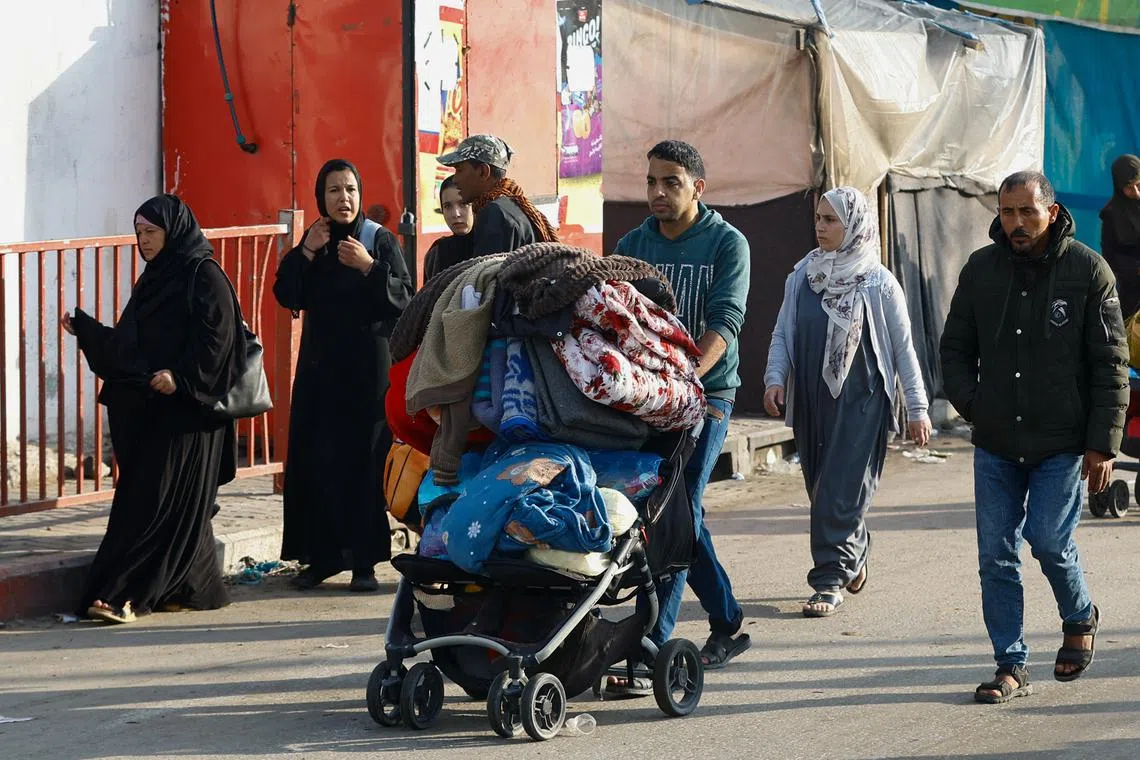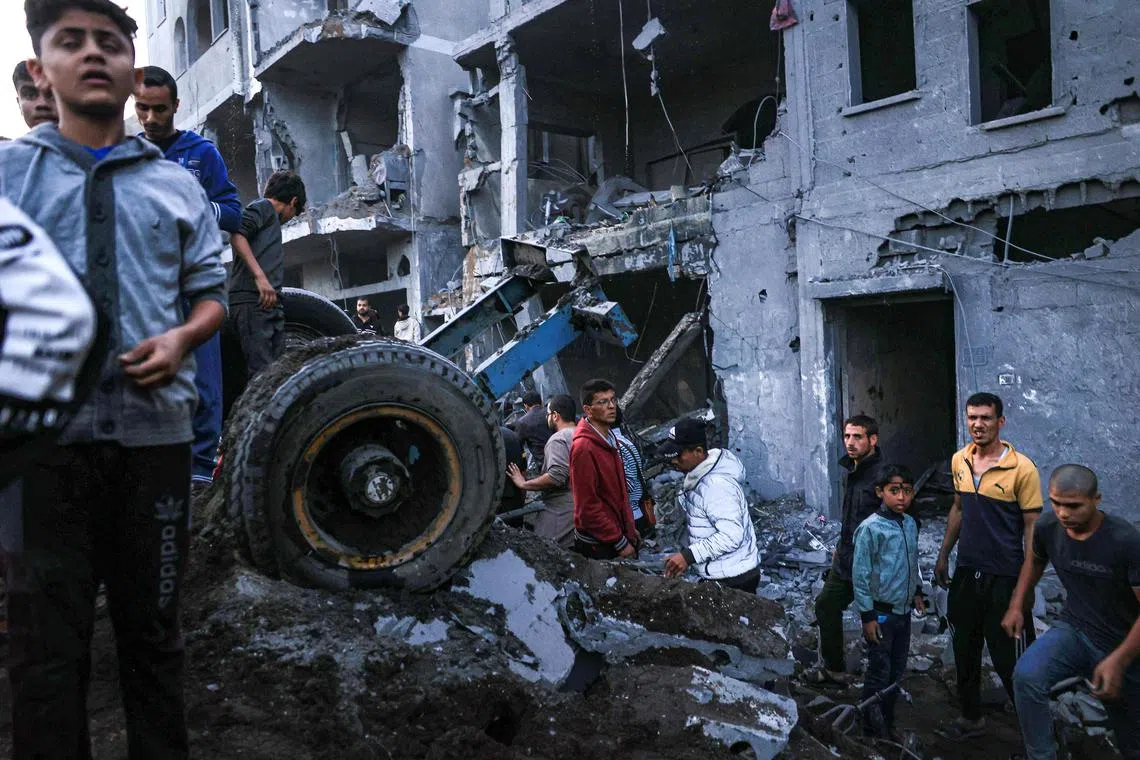Israel orders Gazans out of swathes of Khan Younis as its ground forces move south
Sign up now: Get ST's newsletters delivered to your inbox

Palestinians fleeing their houses due to Israeli strikes in the eastern part of Khan Younis on Dec 1.
PHOTO: REUTERS
Follow topic:
GAZA/CAIRO – Israel ordered thousands out of Gaza’s main southern city on Dec 4 as it pressed its ground campaign deep into the south, sending desperate residents fleeing even as bombs fell on areas still described as safe.
Israel’s military posted a map on X (formerly Twitter) with around a quarter of the city of Khan Younis marked off in yellow as territory that must be evacuated at once. Three arrows pointed south and west, telling people to head farther towards the Mediterranean Sea and the Egyptian border.
Many of those taking flight were already displaced from other areas. They had been sleeping in makeshift shelters with their few remaining belongings in plastic bags.
Mr Abu Mohammed said it was now the third time he had been forced to flee since abandoning his home in Gaza City in the north.
“Last night, Israeli tanks shelled from the east and the north and the west too from (naval ships in) the direction of the sea. (There were) rings of fire around us, and the house kept shaking, and was covered in red light from the explosions, causing panic and horror for the adults and the children alike,” he said.
“Why did they eject us from our homes in Gaza (City) if they planned to kill us here?” he asked.
At a home in Khan Younis that was struck overnight, flames licked the collapsed masonry and grey smoke billowed out from the rubble. A child’s stuffed sheep toy lay in a pile of dust. Boys were picking through the wreckage with their bare hands.
Next door, Ms Nesrine Abdelmoty stood amid damaged furniture in the rented room where she lived with her divorced daughter and two-year-old baby.
“We were sleeping at 5am when we felt things collapse. Everything went upside down,” she said. “They told (people) to move from the north to Khan Younis, since the south is safer. Now, they’ve bombed Khan Younis. Even Khan Younis is not safe now, and even if we move to Rafah, Rafah is not safe as well. Where do they want us to go?”
As many as 80 per cent of Gaza’s 2.3 million people have fled their homes in an Israeli bombing campaign that has reduced much of the crowded coastal strip to a desolate wasteland.
Medical officials in the enclave say the air strikes and ground assaults have killed at least 15,899 people, with thousands more missing and feared buried in rubble.
Israel launched its assault to annihilate Hamas in retaliation for an Oct 7 attack by the militant group that left 1,200 people dead
Israel heads south
Israeli forces largely captured the northern half of Gaza in November. Since a week-long truce collapsed on Dec 1
Tanks driving into Gaza from the border fence in the east along the road that divides Khan Younis from the city of Balah al-Deir farther north have reached a flour mill halfway to the Mediterranean coast, cutting off the main north-south road.
“The IDF (Israel Defence Forces) continues to extend its ground operation against Hamas centres in all of the Gaza Strip,” Israel’s top military spokesman, Rear-Admiral Daniel Hagari, told reporters in Tel Aviv. “The forces are coming face-to-face with terrorists and killing them.”
The IDF released footage of troops patrolling in tanks and on foot, in fields and in badly damaged urban areas, and firing from weapons, without specifying the location inside Gaza.
Israeli government spokesman Eylon Levy said the military struck more than 400 targets over the weekend, “including extensive aerial attacks in the Khan Younis area”, and killed Hamas militants and destroyed their infrastructure in Beit Lahiya in the north.
The latest violence took place despite calls from the United States – Israel’s closest ally – for Israel to limit harm to Palestinian civilians
On Dec 3, Hamas said its fighters clashed with Israeli troops about 2km from the southern city of Khan Younis.
Israel said its military death toll from ground operations in Gaza had risen to 76.
More casualties
Early on Dec 4, Hamas media quoted emergency services as saying an Israeli strike killed three civil emergency workers in Gaza City in the north of the coastal enclave.
The Jabalia refugee camp in the north of Hamas-ruled Gaza was among the sites reported hit from the air on Dec 3. A Gazan Health Ministry spokesperson said several people were killed by an Israeli air strike.
Footage seen by Reuters showed a boy covered in grey dust, sitting weeping amid crumbled cement and rubble from collapsed buildings.
“My father was martyred,” he cried in a hoarse voice. A girl in a pink sweatshirt, also coated with dust, stood amid rubble.

Palestinians surveying the damage after an Israeli strike in Rafah in the southern Gaza Strip on Dec 3, 2023.
PHOTO: AFP
Attacks on shipping in the southern Red Sea on Dec 3 heightened fears of the conflict spreading.
The US Department of Defence said three commercial ships were attacked
A Houthi spokesperson said the group’s navy attacked two Israeli ships in the Red Sea with an armed drone and a missile on Dec 3, though an Israeli military spokesman said the two ships had no connection to Israel. REUTERS

